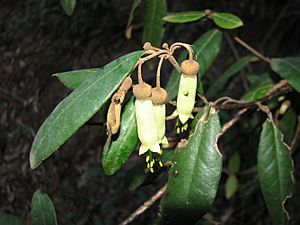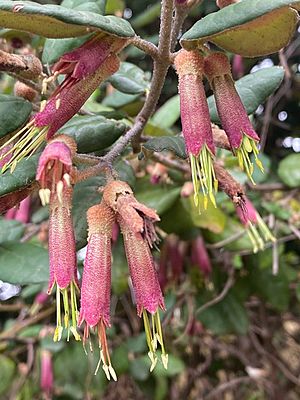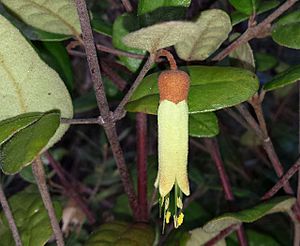Mountain correa facts for kids
Quick facts for kids Mountain correa |
|
|---|---|
 |
|
| Correa lawrenceana var. latrobeana in Yarra Ranges National Park | |
| Scientific classification | |
| Genus: |
Correa
|
| Species: |
lawrenceana
|
| Synonyms | |
|
|
The Mountain Correa (Correa lawrenceana) is a special type of shrub or small tree. It belongs to the Rutaceae family, which also includes citrus fruits! This plant is found only in Australia, meaning it's endemic there. It has leaves that look like ellipses or eggs, growing in pairs. Its flowers are shaped like tubes and can be greenish-yellow to red. These flowers usually grow one by one or in small groups where the leaves meet the stem. Inside the flowers, you'll see tiny parts called stamens sticking out.
Contents
What Does the Mountain Correa Look Like?
The Mountain Correa is usually a shrub, growing from about 0.6 to 9 meters (2 to 30 feet) tall. Sometimes, it can even grow into a small tree, reaching up to 16 meters (52 feet) high! Its young branches are covered with rusty-colored hairs.
Leaves and Flowers
The leaves grow in pairs opposite each other on the stem. They are shaped like an ellipse or an egg. Each leaf can be from 1.3 to 12 centimeters (0.5 to 4.7 inches) long and 0.7 to 7 centimeters (0.3 to 2.8 inches) wide. They sit on a small stalk called a petiole, which can be up to 1.6 centimeters (0.6 inches) long.
The flowers usually grow alone or in groups of up to seven. They appear where the leaves join the stem, which is called a leaf axil. Each flower has its own small stalk, called a pedicel, which can be 0.5 to 5 centimeters (0.2 to 2 inches) long.
Flower Parts
At the base of the flower is a cup-shaped part called the calyx. It's usually 0.3 to 1 centimeter (0.1 to 0.4 inches) long. The main part of the flower is the corolla, which is shaped like a tube. It can be greenish-yellow to red and feels scaly or velvety. The corolla is 1.2 to 5 centimeters (0.5 to 2 inches) long and has four short tips at the end. The stamens, which are the parts that hold pollen, stick out far beyond the end of the corolla. Mountain Correa plants usually flower in spring, but you might see flowers at other times of the year too.
How Was it Named?
The Mountain Correa was first described in 1834 by an English botanist named William Jackson Hooker. He published its description in his science journal. He originally named it Correa lawrenciana.
Honoring a Botanist
The plant was named after Robert William Lawrence, a botanist from Tasmania. He, along with another person named Ronald Gunn, collected the plant samples that were sent to Hooker. Later, in 1998, another botanist named Paul G. Wilson corrected the name to Correa lawrenceana. This was done to follow the rules for naming plants, which are found in the Tokyo Code.
Different Types of Mountain Correa
Scientists have also identified a special group within the Correa family called Correa subgenus Persistens. This group includes the Mountain Correa and one other species, C. baeuerlenii. Unlike many other Correa species, the Mountain Correa doesn't easily mix with other types of Correa to form new kinds of plants.
There are eight different types, or varieties, of Mountain Correa that scientists recognize. These varieties can look a bit different from each other, for example, in the shape of their leaves or the color of their flowers. Some of these varieties include:
- Pink Mountain-Correa (Correa lawrenceana var. cordifolia)
- Genoa River Correa (Correa lawrenceana var. genoensis)
- Grampians Mountain-Correa (Correa lawrenceana var. grampiana)
It's important to know that sometimes these varieties can blend into each other, so it's not always easy to tell them apart perfectly.
Where Does the Mountain Correa Grow?
The Mountain Correa grows in different types of forests in Australia. You can find it in rainforests and sclerophyll forests. It grows in Tasmania, Victoria, New South Wales, the Australian Capital Territory, and Queensland.
Specific Locations for Varieties
Each variety of Mountain Correa tends to grow in certain areas:
- The cordifolia variety grows in forests along the coast and tablelands of southern New South Wales, the Australian Capital Territory, and north-eastern Victoria.
- The genoensis variety is only found near the Genoa River, close to the border between New South Wales and Victoria.
- The glandulifera variety grows in the mountains from the Gibraltar Range in New South Wales up to the McPherson Range in south-eastern Queensland.
- The grampiana variety likes to grow among rocks in mountain areas, especially in the Grampians.
- The latrobeana variety is found in south-eastern New South Wales and eastern Victoria.
- The lawrenceana variety grows in mountainous parts of Tasmania and the Australian Capital Territory.
- The macrocalyx variety is in mountainous areas between the Taree and Illawarra regions in New South Wales.
- The rosea variety is only found in the Snowy Mountains of New South Wales.
Ecology and Pollination
Scientists believe that the flowers of the Mountain Correa are pollinated by either birds or bees. This means these animals help the plant reproduce by carrying pollen from one flower to another.
Growing Mountain Correa in Your Garden
The Mountain Correa is a great plant for gardens, especially if you live in a cool, moist area with some shade. It can handle frost and even snow! Because it grows quite tall, it can be used as a screen to give you privacy in your garden. It also attracts honeyeater birds, which are beautiful to watch.
If you want to grow Mountain Correa, it's easy to start new plants from cuttings (small pieces of the plant). Growing them from seeds can be a bit trickier.
See also
 In Spanish: Mountain Correa para niños
In Spanish: Mountain Correa para niños



